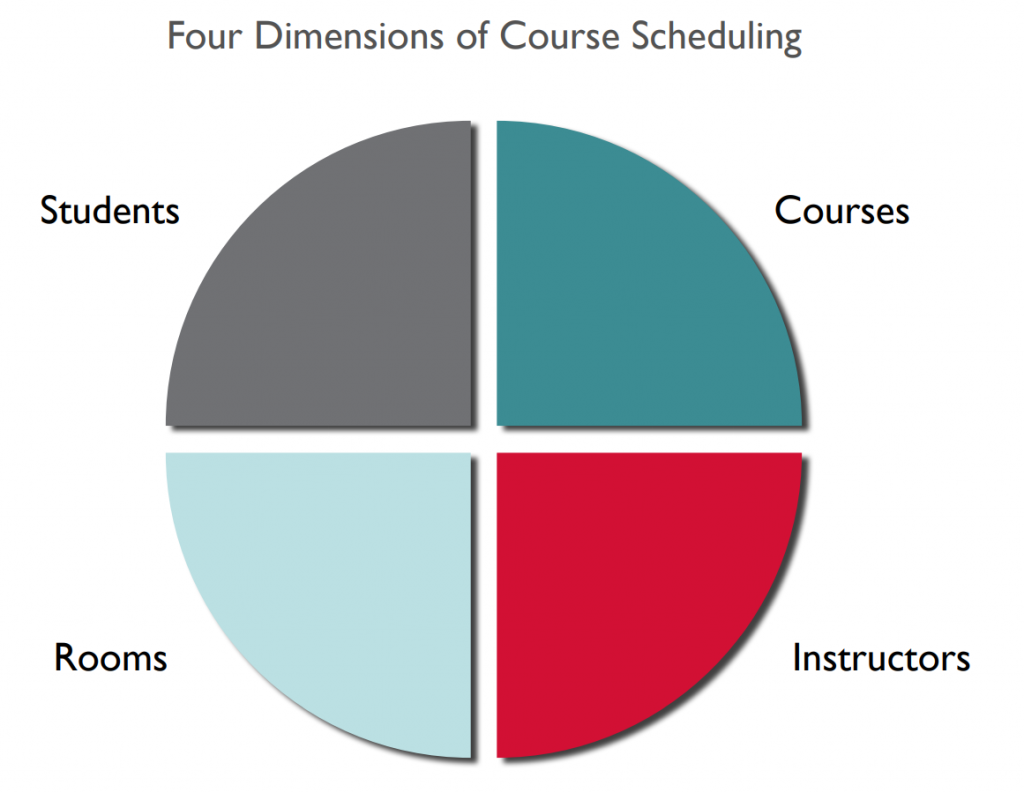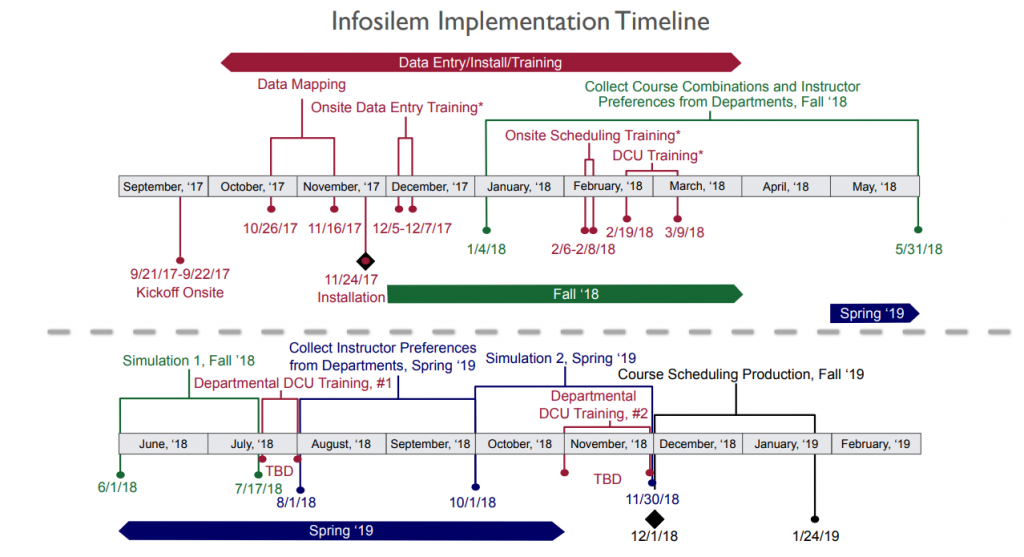
Table of Contents
Scheduling
Creating the schedule of classes is a daunting task that is nearly a one year process. This starts off by “rolling over” the previous years schedule as the starting point. Departments then adjust the schedule according to their own curricula and send them over to the scheduling office for approval. This process involves organizing classes into different times and rooms based on the curriculum of their students and then assigning professors to teach them.

Infosilem
Instead of having to create the schedule manually, Infosilem, a software developed by Berger-Levrault, uses an algorithm to systemically create new, efficient schedules. This algorithm has parameters to optimize scheduling.

Analysis of Interview with the Director of Scheduling: Dr. Christopher Morit
Issues with the old System
- Rolling over the system from the previous year is that certain temporary accommodations that are made are rolled over into the next period and will be present the consecutive year. A professor may have a special need and can only teach at certain times. When he requests for these times, it creates inefficiencies for other classes. The downside of rollover is that when this professor is done teaching, this inefficiency is still carried over even when there is no longer any need.
- When certain courses are capped, there is no way for the current system to account for how many students went over the cap. This makes it hard for the office to know how many more classrooms they have to open up and how many more professors they have to staff.
- Once the Departments create their respective schedules they send it over to the office for approval. This process is a complex task that involves the coordinated between many different departments in order to make sure that different schedules mesh together cohesively.
Infosilem
How it works
- The algorithm also starts off with the previous year, but it does NOT rollover the time or classroom.
- The system has a metric that measures the overall utility value of each different schedule format. The parameters for these metrics involve minimizing student travel time, satisfying faculty schedule preferences, maximizing classroom space usage, and more.
- Using this metric the algorithm sorts the schedule by optimizing this metric.
- The algorithm does not sort labs and general purpose classrooms.
How Faculty interact with Infosilem
Faculty can request two types of hard and soft constraints
- Hard Block-offs: Faculty can make certain hours unavailable through blackouts under 4 categories: Medical Conditions, religious observance, disability needs, or schedules University obligations.
- Soft Preferences: Faculty are able to put in times that they prefer to teach during. The system will do its best to accommodate these hours.
The Benefits
- Infosilem has been extensively used in other Universities to great success.
- The algorithm is much more efficient. Many of the issues that were brought up during the old system such as the temporary accommodations, are solved now that an algorithm is used to create the schedule and the times and locations of the previous year aren’t rolled over.
- The number of available classrooms actually went up. If 10 years down the line, the algorithm saves building a new building, it pays for itself.
- The amount of intercampus travel actually went down for students
- 89% of faculty got the campus they requested during testing phase

- One of the most prominent complaints was the lack of childcare option for hard blockoffs for faculty teaching preferences. This leads faculty to believe that this new software could be a possible way to “cut out” certain excuses for unavailability.
- There is a lack of human interface so people are unable to empathize with each other.
- Many of the complaints made about infosilem were unbased and are mainly from fear of the unknown.
- It does not save labor, as the Office still has to go through flags in the system and coordinate with other departments to resolve these flags.
Faculty grievances pose important questions regarding the nature of implementing Infosilem, it removes the human aspect from scheduling and reduces it to a simple algorithm that doesn’t understand the complexity of human life. Certain aspects such as child-care being left out of block scheduling poses enormous issues for employees who have children. Infosilem could never hope to understand the time and effort that goes into raising and caring for a child and its implementation would be detrimental to some employees schedules. This sort of trend in scheduling changes is not unique to Rutgers as it has been occurring throughout the United States as technology continues to develop, while this sort of technology may make a managers life easier it causes much more stress and limits the employee to operating within the algorithm. This further forces people to live their physical, human lives in the context of a digital world, much like students are force to interact with digital technology in their social and academic careers, adults and employees are now forced to interact with a digital technology in the workplace scheduling. This sort of reliance of digital technology to perform essential human tasks and to understand the complexity of human lives is dangerous as the potential to negatively impact human lives in great.
Source of figures
Rutgers–New Brunswick Office of Academic Scheduling and Instructional Space, Infosilem Course Scheduling Town Hall Meeting slidedeck, February 23, 2018 (?). URL unavailable.
